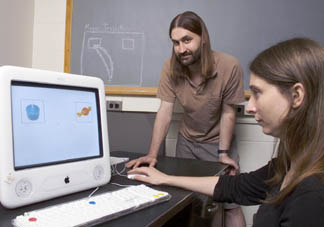Staffing the State Department
January 30th, 2005Someone I know recently shared with me their experience in applying for a job at the State Department. I’m interested because I thought it might cast light on why the State Department, in spite of being filled with such bright folks, hasn’t accomplished anything useful for at least the past four years. And it does.
First, the testing process. You start off by taking the Written Examination, which about 20% of the applicants pass. Next, you take the Oral Assessment, which sounds like they are checking out your teeth. It’s an all day interview and role-playing exercise, also with a low pass ratio.
My friend failed the test, although she did pass one of the three components—the so-called “Case Management” part, where you are given a situation in the form of a bunch of materials to read, analyze, think about, and then come up with recommendations in the form of a written memo.
This was the component where some doubts began to arise in her mind: why, in order to join the elite Foreign Service of the United States, are applicants given a problem involving re-orging a five-person department at the embassy in a fictional Arab country that can’t seem to get its visas issued? Managing the janitorial crew at the local Wal-mart would probably be more challenging, involve at least as many cross-cultural issues (at least here in LA), and could well pay as much, although I’m sure State’s dental plan is better.
But her main problem was the so-called “Structured Interview” part of the day, one of the two components (the other being the “Group Exercise”) she didn’t pass.
The lead-off question was why she wanted to work at State. Now, everyone knows this is coming, and everyone has an answer ready, but guess what: you have to really know why you want to get this job. It’s not enough to say I like foreign countries, or I think it would be cool to live in SOUTH KANUBISTAN, or I love the idea of sitting in a little booth all day stamping visas in the Kanubis’ passports, or the $400 per month in hazardous duty pay sounds great when all I have do to get it is get shot at occasionally. You have to have a real reason. This is harder than it sounds because, in actuality, there are not very many good reasons to want to work at State.
Forty years ago, oh my, were these people at the top of the heap—sort of like a diplomatic version of those glamorous stewardesses who, can you imagine, got to travel to other countries, including ones with weird names on exotic continents! Turns out that in 2005, State employees are still like stewardesses: grossly overworked, horrifically underpaid, challenged only by the masses of unwashed screaming customers below and clueless bureaucrats above.
But wait: some Foreign Service officers may rise to the exalted level of ambassadorship, right? Not really, if it’s an important country—in that case, like in Japan recently, Bush will appoint one of his fund-raiser cronies, while your job is to fetch him a glass of water. Even if you did become ambassador to some little third-world country, your job is basically reading the memos that come from DC and managing other sad American souls like yourself who responded to the siren call of a life in the “diplomatic corps”, and then made the mistake of actually passing the Oral Assessment. Or, you might become one of the Examiners administering the “Assessment” yourself! My friend reports, though, that the ones examining her did not look especially pleased with their lot in life; one told her that this exact same daily grind, looking at loser after loser day after day, was going to continue until the end of March.
You might also get a job organizing parties at the embassy! This was the topic of one of the “hypothetical questions” that form part of the structured interview. Such complex questions quite likely account for the high failure rate—only really savvy party folks are going to be entitled to bear the mantle of planning America’s parties in distant lands.
All in all, though, or so my friend opines, the Oral Assessment process seems to have functioned well. She and State looked at each other and decided they didn’t want to work together, and the feeling was entirely mutual.
All the guys at State are real smart and I’m sure there are good reasons for why they put together this kind of test. The results of decades of la creme de la creme passing through this eye of the needle is that the State Department is now staffed with the absolute best and brightest. But unfortunately, over the last four years at least, they have been, at best, mere bystanders in the process of American diplomacy; the real decisions were made by the neocon hawks. Smart guys at State counseled against going into Iraq and urged more planning at a minimum, but were essentially told to go bork themselves. State has basically ended up cleaning up Cheney’s and Rumsfeld’s mess, and will continue to do so for many years to come. The State people knew that we should continue to engage North Korea; Bush thought he knew better. The State people knew that we should continue exercising our good offices in the conflict in the Middle East; Bush thought that was too “Clintonian” and our entire diplomatic involvement in the Middle East was essentially terminated for the first three years of his term while the problem festered. Meanwhile, ignored and isolated, Colin Powell’s exemplary integrity did not quite extend to doing the obvious, namely resigning; instead, he let himself be manipulated into giving the ridiculous dog and pony show at the UN where he repeated in front of the world the fabricated intelligence about WMDs in Iraq. Now, should you be lucky enough to pass through the golden gates of State, your boss will be the person who herself helped create those fabrications, and amazingly, reiterated at her confirmation hearings that everything went great in Iraq and she wouldn’t do a single thing differently.
But have no fear: through thick and thin, the brave men and women of State will continue valiantly to stamp visas and plan parties.

 Michael Spivey (pictured) and his collaborators at Cornell did a cute little study, where they tracked the movement of the subject’s mouse as they tried to move it toward a picture on the computer screen corresponding to the word they had just heard. When the two pictures were of items whose lexical representations are “close” (think “candy” vs. “candle”) the mouse darted tentatively toward one before converging on the correct one. As the authors say in the
Michael Spivey (pictured) and his collaborators at Cornell did a cute little study, where they tracked the movement of the subject’s mouse as they tried to move it toward a picture on the computer screen corresponding to the word they had just heard. When the two pictures were of items whose lexical representations are “close” (think “candy” vs. “candle”) the mouse darted tentatively toward one before converging on the correct one. As the authors say in the  Dr. Deepak Chopra’s (picture) (
Dr. Deepak Chopra’s (picture) ( We humans owe a debt of gratitude to fish—after all, it’s a little bump that developed in their spines that is believed to be the precursor to the human brain. All the more reason to be concerned about preserving the salmon. In my
We humans owe a debt of gratitude to fish—after all, it’s a little bump that developed in their spines that is believed to be the precursor to the human brain. All the more reason to be concerned about preserving the salmon. In my  I still remember the first time I saw and held a
I still remember the first time I saw and held a  But the Japanese also did not overlook the entrails, which they extract, salt, and cure (see picture). The result: konowata (æµ·é¼ è…¸), considered one of the three major chinmi (delicacies) of Japan.
But the Japanese also did not overlook the entrails, which they extract, salt, and cure (see picture). The result: konowata (æµ·é¼ è…¸), considered one of the three major chinmi (delicacies) of Japan.
 With a title like
With a title like 
 Religion contributes to a more stable, healthy, prosperous society. Right?
Religion contributes to a more stable, healthy, prosperous society. Right?